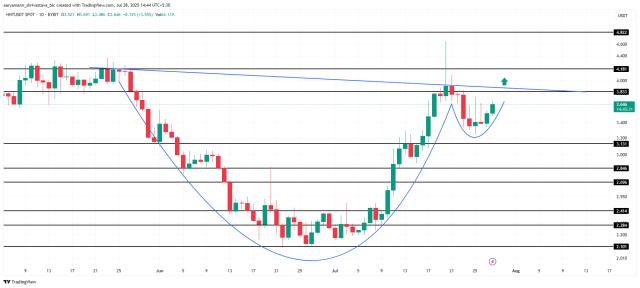USDD 2.0 celebrates six months with $600M+ TVL, strong over-collateralization, and a multi-layered stability framework including Smart Allocator for sustainable yield.
The Genius Act introduces strict U.S. stablecoin regulations, pushing projects toward transparency, full reserves, and compliance, while offshore regions may attract innovation.
Experts predict yield-bearing and modular stablecoin systems will shape the future, balancing compliance, flexibility, and institutional adoption.

1. INTRODUCTION OF AMA GUESTS AND HOST
📍 Hosted by
Host: Miki (from Coin Rank)
👥 Featuring crypto experts & builders:
- USDD 2.0 @usddio — Co-Host. Team member Bella gave the introduction.
- Bannon (from Myro Pay) — Myro Pay is developing new advanced payment solutions.
- Nora (from Stargate) — Community manager of Stargate. Stargate is a super aggregation incubation platform based on AI blockchain architecture.
- Olly Grant (from Tote) — Tote helps users use crypto in the real world with virtual/physical debit cards, enabling real-time USDT to fiat conversion.
- Tom (from C Wallet) — C Wallet is a custodial and non-custodial Web 2.5 wallet, integrating multiple blockchains and tokens, offering payroll, large payment tools, and credit card services.
- Anna (from AIN (All In)) — Global ambassador of AIN. AIN is the world’s first full-chain RWA asset management and trading platform.
This AMA was hosted by Miki from Coin Rank and co-hosted by the USDD team. It aimed to celebrate the 6-month milestone of USDD 2.0 and explore the future of stablecoins in the new regulatory environment.
2. USDD 2.0 SIX-MONTH MILESTONE ACHIEVEMENTS AND CORE MECHANISMS
Bella from USDD explained USDD 2.0’s performance over the past six months. She highlighted its role as a decentralized, over-collateralized, yield-generating stablecoin and its strong growth.
Key Metrics:
Total Value Locked (TVL) over $600 million, showing strong user participation and ecosystem confidence.
Collateral ratio stays strong at 105% to 120%, ensuring stability even in volatile markets.
Offers attractive, tiered 20% APY returns.
STRX voting performance stands out, with TVL reaching $8.26 million and very low stability fees.
Circulating supply keeps growing steadily, managed by on-chain collateral and community demand.
User growth is strong, with over 442,000 total token holders and 201,700+ community members (across X/Twitter, Telegram, Discord, etc.).
Stability Mechanism:
USDD 2.0 uses a multi-layer stability framework, combining the PSM module, safety liquidation, auction system, and strong over-collateralization.
PSM (Peg Stability Module): The first defense line for peg stability. Allows 1:1 swap between USDT and USDD with zero slippage and almost no gas fee, giving users arbitrage incentives.
All USDD is over-collateralized by real assets at 105% to 170%.
Safe liquidation system: If collateral value drops below the threshold, users are incentivized to trigger liquidation and get rewards, recovering undercollateralized debts in a timely and decentralized way.
On-chain auctions and dynamic risk control: Liquidated assets are sold via transparent on-chain auctions. Parameters (like collateral types, limits, stability fees) are adjusted based on market conditions.
Smart Allocator Module:
Introduces a safe, transparent, and sustainable on-chain yield engine.
Allocates some idle assets from PSM to tested DeFi protocols (like Aave and JustLend) to earn sustainable yields.
Core design principles include full on-chain transparency, protocol whitelist (only selects high-liquidity and secure protocols), continuous strategy review and adjustment, and smart contracts audited by CH Security.
This module prioritizes stability, ensures peg defense and PSM liquidity are not affected, and aims to improve capital efficiency.
3. THE FUTURE OF STABLECOINS IN THE REGULATORY ERA
The second part of the AMA focused on the Genius Act—the first federal-level stablecoin regulation law in the U.S.—and its impact on global stablecoin innovation and competition.
Impact of the Genius Act:
Anna (AIN) said this law brings stablecoins into a mainstream regulatory framework. It will favor projects with transparency, enough reserves, and regulatory compliance. Offshore projects may rethink strategies, and compliant stablecoins may see increased institutional adoption.
Nora (Stargate) added that the Act will tighten regulation and raise entry barriers. Only licensed banks or institutions meeting strict standards can succeed. The 1:1 reserve requirement (like cash or short-term Treasuries) will boost trust and attract institutions. She also said the law may create a “dual dynamic” globally — U.S. stablecoins gain advantages, while regions like Singapore and UAE may offer looser regulation to attract innovators.
Future of Yield-Bearing Stablecoins:
Olly Grant (Tote) said two types of stablecoins may appear: highly regulated/low-yield products (for institutions and mainstream users) and high-yield/experimental products (may move to looser jurisdictions). Even under regulation, a 4-6% yield is better than traditional savings (0.5-1%). Tote aims to let users earn yield on USDT while spending in the real world.
Nora (Stargate) noted the Genius Act may ban yield-bearing tokens in the U.S. and require monthly reserve disclosures by crypto-native issuers. However, UAE and others may allow more flexibility. To succeed under regulation, yield-bearing stablecoins may need to integrate with compliant, well-funded systems and use low-risk assets like short-term U.S. Treasuries. This might reduce yields but attract institutional money.
Future Role of Modular Yield Systems:
Bannon (Myro Pay) predicted modular yield systems (like Smart Allocator and RWA routers) could become standard infrastructure. The law promotes fully collateralized, low-risk models, which match well with modular, composable systems in DeFi. These are flexible, easy to add compliance features, and connect TradFi and DeFi via the RWA layer.
Anna (AIN) believes modular systems will be core infrastructure. She said this shift means moving from monolithic protocols to flexible, composable systems. Users can choose where funds go, how to manage risk, and what regulatory controls to use. These systems offer yield, transparency, auditability, and legal integration. They could become the middleware connecting crypto-native users, institutions, regulators, and drive global adoption.
4. COMMUNITY VOTE RESULTS
Near the end of the AMA, the host shared the results of a community vote. Most users believed “over-collateralized safety” is the most important factor for next-generation stablecoins. The host said peg stability starts with strong collateral support, and USDD’s system (liquidation logic and mechanisms) is designed to absorb shocks and protect the peg.
This AMA covered USDD 2.0’s progress in both technology and market performance. It deeply explored how USDD ensures stability and growth with its innovative mechanisms. It also discussed how the stablecoin industry might evolve after the Genius Act—especially the future of yield-bearing stablecoins and modular yield systems. All guests agreed: compliance, transparency, and sustainability will be the core of stablecoin development going forward.
〈7/25 AMA:Stability Meets Sustainability in the Age of Regulation〉這篇文章最早發佈於《CoinRank》。







